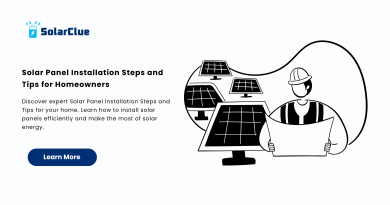How Do Solar Panels Make Electricity?
Solar panels are a marvel of modern technology, converting sunlight into usable electricity through the photovoltaic (PV) effect. This blog will take you through the science behind solar energy, the structure of solar panels, and how they work to power homes and businesses. We’ll also discuss factors affecting solar panel efficiency and ways to maximize power output.
Table of Contents
- 1 The Science Behind Solar Energy
- 1.1 The Photovoltaic Effect in Detail
- 1.2 Structure of a Solar Panel
- 1.3 Conversion of Direct Current (DC) to Alternating Current (AC)
- 1.4 Factors Affecting Solar Panel Efficiency
- 1.5 Maximizing Power Output
- 1.6 Comparing Solar Panels to Traditional Power Sources
- 1.7 The Future of Solar Panel Technology
- 1.8 Common Misconceptions About Solar Power
- 1.9 Conclusion
- 1.10 Key Components and Their Roles in Solar Panels
- 1.11 FAQs
The Science Behind Solar Energy
The core principle behind solar panels is the photovoltaic effect, a process where light energy (photons) is converted into electrical energy (electrons).
- Photons: Particles of light that carry energy from the sun to the Earth.
- Electrons: Subatomic particles within atoms that carry a negative charge and can move through a material to create an electric current.
- Semiconductors: Materials, often silicon, that form the basis of solar cells. These materials have properties that allow them to absorb photons and release electrons.
The Photovoltaic Effect in Detail
When sunlight hits a solar cell, the energy from the photons excites electrons in the semiconductor material, typically silicon. This excitation causes the electrons to break free from their atoms and flow through the material, creating an electric current.
| Component | Role in Photovoltaic Effect |
|---|---|
| Photons | Provide the energy needed to excite electrons. |
| Electrons | Flow through the semiconductor to generate electricity. |
| Semiconductors (Silicon) | Absorb photons and release electrons, enabling the flow of current. |
Structure of a Solar Panel
A solar panel is made up of several components, starting from individual solar cells to a complete module:
1. Solar Cells: The basic building blocks of a solar panel, usually made from silicon. Each cell produces a small amount of electricity.
2. Cell Arrangement: Solar cells are arranged in a grid pattern within the panel. The cells are connected in series and parallel to increase voltage and current output.
3. Encapsulation: The cells are encapsulated to protect them from environmental damage, using materials like EVA (ethylene vinyl acetate) and backsheet for insulation.
4. Glass Covering: A layer of tempered glass is placed on top to protect the cells while allowing sunlight to pass through.
5. Frame: The entire assembly is enclosed in a frame, usually made of aluminum, providing structural support and allowing for easy mounting.
Conversion of Direct Current (DC) to Alternating Current (AC)
Solar panels generate direct current (DC) electricity, which flows in one direction. However, most homes and businesses use alternating current (AC) electricity, where the current changes direction periodically. Inverters are used to convert DC electricity generated by solar panels into AC electricity.
| Component | Function |
|---|---|
| Solar Panels | Generate DC electricity from sunlight. |
| Inverter | Converts DC electricity to AC electricity for use in homes and businesses. |
Factors Affecting Solar Panel Efficiency
Several factors can influence the efficiency of a solar panel, including:
1. Material Quality: Higher quality materials, such as monocrystalline silicon, generally offer better efficiency.
2. Temperature: Higher temperatures can reduce the efficiency of solar panels as they cause more resistance in the electrical circuit.
3. Angle of Installation: Solar panels should be installed at an angle that maximizes exposure to sunlight.
4. Shading: Any shading on the panels can significantly reduce their efficiency, as it prevents sunlight from reaching the cells.
Maximizing Power Output
To get the most out of your solar panels, consider the following:
1. Optimal Placement: Ensure panels are placed in a location with maximum sunlight exposure throughout the day.
2. Regular Maintenance: Keep panels clean and free of debris to ensure maximum light absorption.
3. Use of High-Efficiency Panels: Invest in panels with higher efficiency ratings for better performance.
Comparing Solar Panels to Traditional Power Sources
Solar panels offer several advantages over traditional fossil fuel-based power sources:
| Aspect | Solar Panels | Traditional Power Sources |
|---|---|---|
| Emissions | Zero emissions during operation. | High greenhouse gas emissions. |
| Energy Source | Renewable (sunlight). | Non-renewable (coal, natural gas). |
| Operational Costs | Low, after initial installation. | High, due to fuel costs and maintenance. |
The Future of Solar Panel Technology
The future of solar technology is bright, with advancements focusing on increasing efficiency, reducing costs, and expanding the applications of solar energy. Innovations such as perovskite solar cells, bifacial panels, and solar windows are expected to drive the industry forward.
Common Misconceptions About Solar Power
1. Solar Panels Don’t Work in Cloudy Weather: Solar panels still produce electricity in cloudy weather, although at reduced levels.
2. Solar Panels Are Too Expensive: The cost of solar panels has decreased significantly, and government incentives can further reduce costs.
3. Solar Panels Require Constant Maintenance: Solar panels require minimal maintenance, mostly involving periodic cleaning and inspections.
Conclusion
Understanding how solar panels generate electricity through the photovoltaic effect and the role of inverters in converting this energy for practical use is essential for maximizing the benefits of solar power. By considering factors that affect efficiency and addressing common misconceptions, you can make informed decisions about using solar energy to power your home or business.
Here at SolarClue®, we offer a smart, practical, and “beautiful” solution. You will be answered for all the questions related to Solar.
We provide all kinds of brands that are the Best Solar panels in India.
If you are the one who is planning for the solar power system. Don’t hesitate to contact our team!
Looking forward to empowering you with solar energy, just like hundreds of our other clients!
Key Components and Their Roles in Solar Panels
| Component | Role |
|---|---|
| Photons | Provide energy to excite electrons in solar cells. |
| Electrons | Create an electric current when excited by photons. |
| Semiconductors | Absorb sunlight and facilitate the photovoltaic effect. |
| Inverter | Converts DC electricity from panels to AC electricity for use. |
FAQs
1. How do solar panels generate electricity?
Solar panels generate electricity through the photovoltaic effect, where sunlight excites electrons in a semiconductor material, creating an electric current.
2. What role do inverters play in a solar power system?
Inverters convert the direct current (DC) electricity produced by solar panels into alternating current (AC) electricity, which is used in most homes and businesses.
3. What factors affect the efficiency of solar panels?
Efficiency can be affected by material quality, temperature, installation angle, and shading.
4. How can I maximize the power output of my solar panels?
To maximize output, ensure optimal placement, maintain cleanliness, and use high-efficiency panels.
5. Are solar panels effective in cloudy weather?
Yes, solar panels can still produce electricity in cloudy weather, although their output will be reduced.



